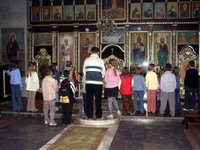
My wife and I have begun to notice a pattern in our two-year-old son’s response to the sacred environment of the sanctuary in the few parishes where we attend Sunday services. When we go to the “traditional” looking church, with its cruciform stone buildings, iconographic Stations of the Cross, rich tapestried reridos, antique wooden crucifix, and golden tabernacle, he repeatedly asks us, “What’s that?”. But when we go to the “modern” looking church, with its circus-tent-like interior school-bricked structure, ambiguous center, Stations hidden on account of its semicircular shape, and complete absence of a reridos, he asks us nothing.
I think we can learn something from children in this situation. We are, as St. Thomas argued against many of his contemporaries, a single substantial form of both body and soul. We ‘are’ our bodies. We also use our bodies, as Aristotle taught, to know, not only the things outside of us, but our very selves. The senses are the doorways through which experience and knowledge passes. The liturgy and the sacred environment as a whole ought to meet us there. Because we are bodies by nature, we are inclined to believe what we experience as beautiful. Divine worship must take seriously the role of the body if it seeks to engage the whole person in a manner consistent with its nature.

No comments:
Post a Comment